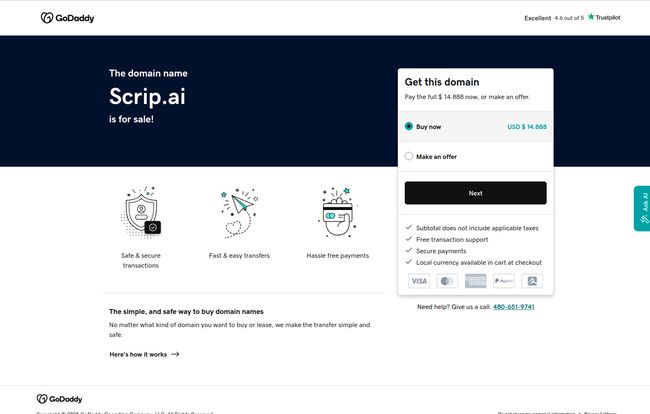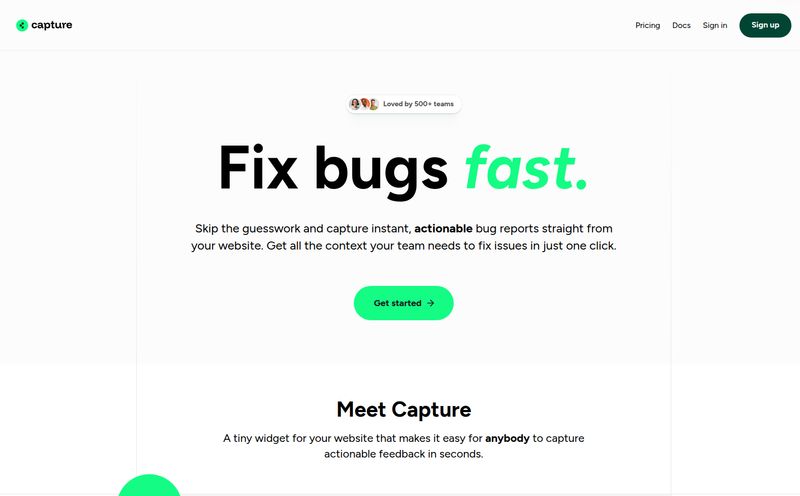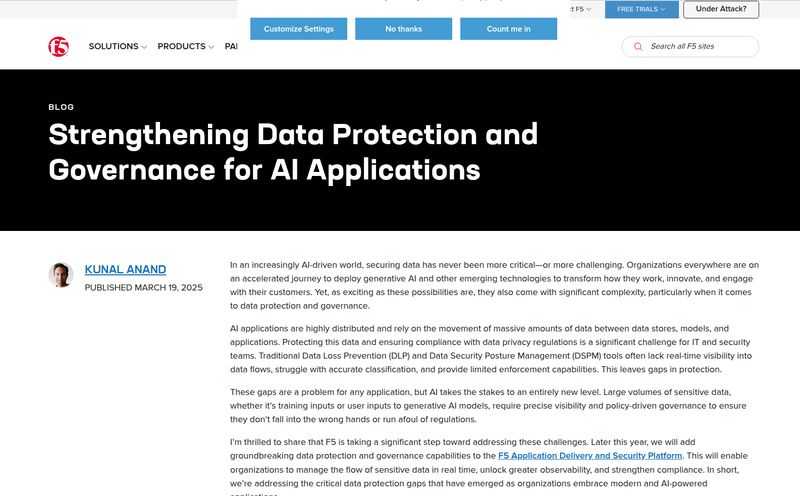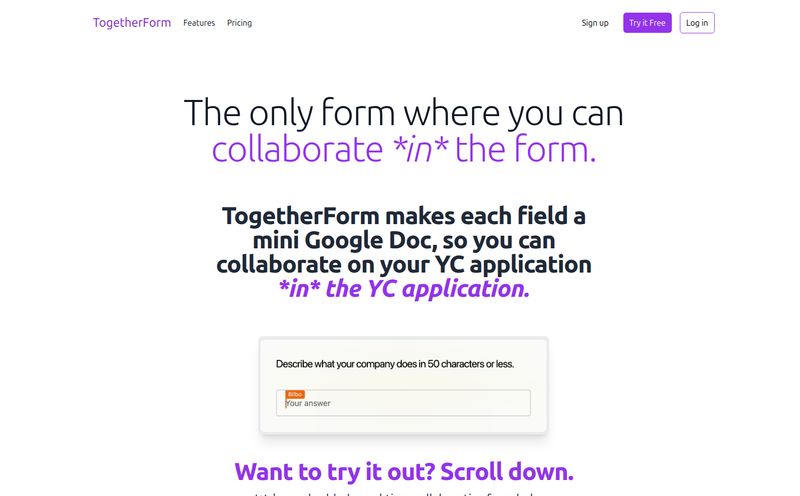As someone who's been swimming in the SEO and digital content pool for years, I've seen my fair share of shiny new tools. Every week, it feels like another AI-powered platform pops up, promising to revolutionize how we write, design, and market. It’s the great AI Gold Rush, and we’re all panning for that one nugget that’ll make our lives easier. So, when Scrip.ai floated across my screen, I was intrigued. The description was simple and sweet: an AI service for text-to-image, articles, and YouTube descriptions. An all-in-one content assistant? Sign me up.
I grabbed my coffee, cracked my knuckles, and navigated to Scrip.ai, ready to kick the tires and see what it could do. But what I found wasn't a sleek dashboard or a friendly user interface. It wasn't even a login screen. What I found was a GoDaddy landing page.
The domain name, Scrip.ai, is for sale.
Honestly, I've seen a lot in this industry, but this was a first. It’s like finding a beautifully designed brochure for a new theme park, driving to the address, and finding an empty field with a giant “Land for Sale” sign planted in the middle. So, this isn't going to be a typical review. Instead, let's go on a little archaeological dig. Let's piece together the story of Scrip.ai, the ghost of a tool that was, and what its story tells us about the current AI frenzy.
What Was Scrip.ai Supposed to Be?
Before we get to the giant digital 'For Sale' sign, what was the dream? Based on the breadcrumbs left behind, Scrip.ai aimed to be a trifecta of content creation. A one-stop-shop for some of the most common needs of bloggers, marketers, and YouTubers.
The core promised features were:
- Text-to-Image Generation: The ability to type a prompt and get a custom image. This is huge, putting it in competition with giants like Midjourney and DALL-E. For bloggers like me, not having to scour stock photo sites is a godsend. The idea of generating a perfectly relevant blog header image right within my writing tool? Yes, please.
- Article Creation: This is the bread and butter for many AI writing assistants like Jasper or Copy.ai. The promise is to help you bust through writer's block, generate outlines, or even draft entire articles. A necessary feature for any tool wanting to play in the content generation space.
- YouTube Video Descriptions: Now this is interesting. It's a bit more niche. While other tools can technically write a YouTube description, having a feature specifically tuned for it suggests an understanding of YouTube SEO—keywords, calls-to-action, timestamp formatting. I have to admit, this specific feature caught my eye. It shows a thoughtful approach to a real-world problem for creators.
This combination is actually quite clever. It covers the full lifecycle of a simple piece of content, like a blog post or video: write the script/article, create a thumbnail/header image, and then optimize the description for discovery. It’s a workflow I go through almost daily. So the idea of Scrip.ai was solid. The potential was there.
The Big Red Flag: A $14,888 'For Sale' Sign
So, back to the elephant in the room. Or rather, the GoDaddy page where a tool should be. The domain `Scrip.ai` is listed for a cool $14,888. You can even make an offer! It’s all very professional, with promises of secure transactions and fast transfers. It's just... not a software product.

Visit Scrip.AI
What does this mean? It's hard to say for sure, but we can speculate. This is where we put on our detective hats.
Scenario 1: The Failed Launch. This is the most likely story. A team or a solo developer had a great idea. They mapped out the features, maybe even built a beta version, and secured a fantastic, brandable .ai domain. But then, reality hit. Maybe they ran out of funding. Maybe the tech was harder to build than anticipated. Perhaps they just couldn't compete in an increasingly crowded market. It's a common tale in the startup world. They decided to cut their losses and sell their most valuable asset: the domain name.
Scenario 2: The Domain Flip. It's also possible that Scrip.ai never existed as a tool at all. Someone savvy could have just bought the domain, created a simple landing page or a listing on a tool directory (which is how I found it), and waited for interest to build up, hoping to sell the domain for a profit to a company that actually wants to build the tool. It's a practice as old as the internet itself, just with a modern AI twist. Its a bit cynical, but definitely plausible.
Scenario 3: The Rebrand. In a more optimistic version of events, the team behind Scrip.ai might have pivoted or rebranded. Maybe they launched under a different name and just put the old domain up for sale. If that's the case, they've done a poor job of redirecting old links, but it’s a possibility.
Whatever the reason, the result is the same: Scrip.ai, as a functional tool, appears to be a ghost ship. A digital Marie Celeste, found adrift with no crew and a valuable cargo (the domain) up for grabs.
Let’s Play Detective and Analyze the Potential
Even if the tool is defunct, the idea isn't. Let's break down the potential it had, because there are lessons to be learned here for both users and developers of AI tools.
An All-in-One Content Hub
I’ve always had a love-hate relationship with all-in-one tools. They're incredibly convenient. The thought of not having to jump between a text editor, an image generator, and an SEO tool is appealing. It smooths out the workflow. However, they often end up being a jack of all trades and a master of none. The writing might be weaker than a dedicated writing tool, and the image generation less powerful than a dedicated image AI. Scrip.ai's success would have hinged on whether it could do all three things well. Not just okay, but well enough to justify not using specialized tools.
The YouTube SEO Angle
I want to come back to the YouTube description generator. This, for me, was the most promising part. Good YouTube descriptions are a weird mix of art and science. They need to be engaging for the human viewer but also stuffed with the right keywords and structure for the algorithm. A tool trained specifically on high-performing YouTube descriptions could be genuinely powerful. It’s a niche that isn’t as saturated as general article writing. This was a smart move, and it's a shame we can't see how it worked in practice.
The Missing Piece of the Puzzle: Pricing
The phantom Scrip.ai was said to have both free and paid plans. This is the classic freemium model. It’s a great way to let users try before they buy. But it also means the free plan has to be good enough to be useful, but limited enough to make you want to upgrade. We’ll never know what the limits were. How many articles per month? How many images? Were there watermarks? The pricing and plan structure is the engine of any SaaS business, and for Scrip.ai, the engine was never even revealed.
A Cautionary Tale for the AI Age
The story of Scrip.ai is more than just a review of a missing tool. It's a snapshot of our current moment in technology. The AI boom is exciting, but it's also chaotic. It reminds me a bit of the dot-com bubble in the late 90s—tons of investment, sky-high promises, and inevitably, a lot of projects that quietly vanish.
For every stable, well-funded AI platform, there are dozens of `Scrip.ai`s out there. Small projects, big dreams, and an uncertain future. It's a reminder for us, the users, to be a little bit cautious. Before you invest time (or money) into a brand new, unheard-of tool, do a little digging. Does the company have a presence on social media? Is there a team listed on their site? Does the domain look like it might be sold out from under you tomorrow?
It's not about being cynical, it’s about being smart. The tools we rely on become part of our workflow, our digital toolkit. And you want to build your house on solid ground, not a vacant lot with a for-sale sign.
Frequently Asked Questions About Scrip.ai
What was Scrip.ai supposed to be?
Scrip.ai was marketed as an all-in-one AI content creation platform. Its main features were supposed to be text-to-image generation, AI article writing, and a specialized tool for creating YouTube video descriptions.
Is Scrip.ai still active?
No. As of late 2023, the domain name 'scrip.ai' is listed for sale on GoDaddy. The tool itself is not accessible, so it's safe to assume the service is not active or never fully launched.
How much does the Scrip.ai domain cost?
The asking price for the scrip.ai domain on GoDaddy is currently listed at $14,888. This price can change, and the page also gives an option to make an offer.
Are there good alternatives to Scrip.ai?
Absolutely. Since Scrip.ai aimed to be an all-in-one tool, you can find alternatives for each of its promised features. For AI writing, look at tools like Jasper, Copy.ai, or Writesonic. For text-to-image generation, the leaders are Midjourney, Stable Diffusion, and DALL-E 3. Many of the writing tools are also starting to integrate image generation.
Why do some AI tools fail to launch?
Many factors can contribute to a tool like Scrip.ai not making it to market. Common reasons include a lack of funding, technical challenges, intense competition from established players, or the founders simply deciding to pivot to a different project. The current AI market is very competitive, making it difficult for new, smaller tools to gain traction.
Conclusion: The Ghost in the Machine
So, there you have it. The review of a tool that wasn't there. The story of Scrip.ai is a fascinating, if brief, one. It represents the immense potential and the harsh reality of the current AI landscape. It had a solid concept, targeting real needs for content creators with a smart combination of features.
But in the end, it's a cautionary tale. A reminder that behind every promising landing page, there needs to be a sustainable, functioning product. While I’m sad I never got to try Scrip.ai, its story has been a memorable investigation. Now, if you'll excuse me, I'm going to go check on the domains of my other favorite tools... just in case.
Reference and Sources
- Domain Sale Listing: GoDaddy.com (The Scrip.ai domain was listed for sale here).
- Information on the AI Startup Boom: For context, articles from tech publications like TechCrunch often cover the funding and challenges of AI startups.



